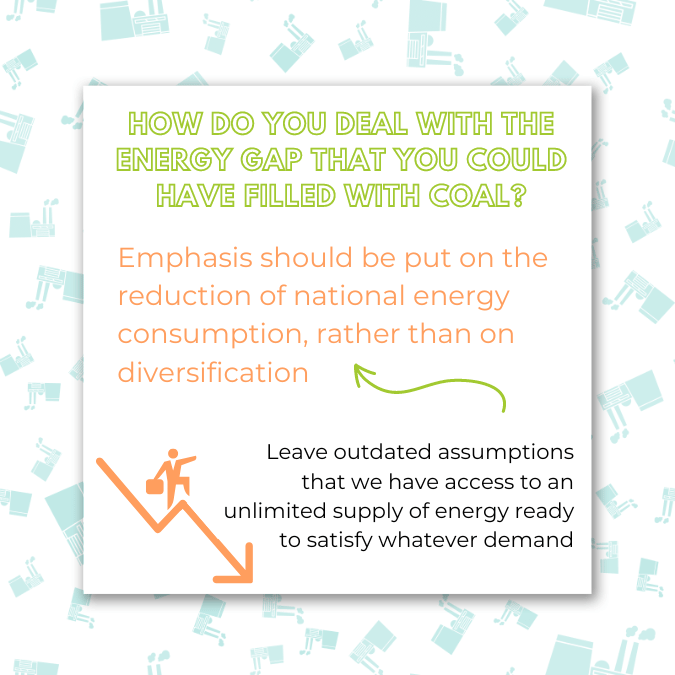The war in Ukraine has highlighted the significance of energy policy as a major power issue. It is an opportunity to break
Germany has a toxic boyfriend
The relation between the country and coal in the context of the climate and energy crises.

How did we end up with an energy crisis in Europe?
The consequences of the sudden cut in oil production caused by the covid-19 pandemic, together with the sanctions (and the related retaliatory policies) that followed the Russian invasion in Ukraine, stifled the supply of fossil fuels to Europe. With gas, coal and oil becoming increasingly harder to source, their price has skyrocketed, thus triggering an energy crisis.
Effect of the Energy crisis in Germany
Of all the countries in Europe, Germany is particularly vulnerable to this disruption in the global fossil fuel supply chain. On the one hand, the country has the highest demand for electricity in Europe. On the other, most of this demand is met by burning imported gas, coal and oil (i.e., those same commodities whose price has gone through the roof recently). To make things worse, until recently the country’s primary supplier was – you guessed it – Russia. I don’t want to bother you too much with the numbers, but in case you are interested here are two detailed sources to learn more about the German Energy Mix and its Fossil Fuels Supply chain.
As of Spring 2022, government officials find themselves in a tricky position. They need to come up with a way to meet the biggest demand for energy in the continent, or else the country’s economy will collapse, but imported fossil fuels are increasingly inaccessible and expensive. To respond to these challenges, a wide set of policies are implemented with the aim to reduce Germany’s dependence on international markets. Some actively foster the energy transition, by boosting investment in renewables and promoting consumer and producer sobriety. Others, however, go in the opposite direction.
Breaking a nine year trend, since 2021 the share of coal used in the country’s energy mix has started to grow again. While in 2019 the government had established a plan to completely phase out coal by 2038, now the priorities seem to have changed. In an effort to replace some of the energy previously produced with Russian gas and oil, it has been decided that 20 coal-burning plants that were supposed to be shut down by 2023 (according to the original timeline) will instead continue operations this year. The inability to source gas from international markets has also been used to provide political legitimacy to the decision to go through with the expansion of the Garzweiler II brown coal (aka lignite) mine, which now also includes the soil under the recently demolished Lützerath.
Not everyone agreed with the idea of destroying this small town in the middle of the Rehin region. Since 2020, thousands of activists had been occupying the area to prevent the expansion of the mine. The argument was simple: if the fuel under Lützerath is burnt, its emissions will make it hard for Germany to meet the emission reduction targets it agreed to in 2015. This claim was backed by the German Institute for Economic Research. In the end, the pro-coal faction won and in late January the village was evacuated, allowing the expansion to start.
Can coal be considered a temporary solution to the energy crisis?
If what we are looking for is an immediate way to provide more energy to the system, increasing coal consumption seems to be an effective and easily achievable — albeit a bit short sighted — solution to the energy crisis. Firstly, internationally sourced hard coal offers a cheaper substitute to the more scarce and more expensive gas. Secondly, lignite is the only fuel that can still be domestically sourced from the country’s active mines. As such, it is a more reliable, less volatile source of energy, whose use contributes to the temporary strengthening of the country’s energy sovereignty. Finally, the infrastructure to turn coal into energy is already there, meaning that increasing capacity requires smaller investments and less time.
Nonetheless, all this comes at a great environmental and social cost. At the global level, coal is the deadliest source of energy. Throughout the world, for every terawatt-hour of electricity produced using hard coal 25 people lose their lives. The figure rises to 32 deaths when we consider lignite (which, as a reminder, is the type of coal that is mined in Germany). Looking more specifically at the case of Germany, coal is responsible for up to 2260 preventable deaths. If you want to learn more about how deadly are other sources of energy, you can check out this interesting visualization made by Statista. The reason behind this macabre first place is pretty straightforward : coal (and especially lignite) releases a high quantity of toxic pollutants in the atmosphere. Talking about first places, the burning of coal is also the single largest contributor to anthropogenic climate change, emitting more CO2 per gigawatt-hour produced than any other fossil fuel. Consequently, if coal is not eliminated from the country’s energy mix fast enough, meeting the emission reduction targets agreed upon in Paris becomes basically impossible, as we were reminded by the “1.5 degrees means Lützerath stays” banner outside the entrance of the occupied town.
The example of Lützerath also points at another important limitation of coal. Lignite mining takes space and in doing so, it destroys both social and natural ecosystems. Since the end of WW2 around 300 cities have been destroyed to make space for extraction operations, with that more than 120 thousand people have been eradicated from their local communities and relocated somewhere else. With that, pieces of cultural heritage have also been demolished, such as the church of St. Lambertus in Immerath. Aside from impacting human settlements, land mining also radically changes the landscapes of the areas in which it is performed, thus destroying the habitat needed for the local flora and fauna to survive and increasing the risk of loss of biodiversity.
Ok, but what do we make of this – maybe a bit disproportionate – pros and cons analysis? In light of what I just said, I would argue that increasing coal use cannot be an answer to the crisis. We know that producing electricity by burning this fuel implies a high environmental and social toll that is hard to justify. Because of this, the government has decided to phase out coal completely by 2038. At the same time, however, to this day coal is still a pillar of the German economy. In 2021, it supplied 30% of the national demand for electricity and, in 2018, it provided almost 40 thousand jobs (this last piece of data is a bit old, but given the trends we described before I would expect up to date figures to still be a sizable number). Consequently, unwinding this deep integration without causing a socio-economic crisis takes time – as shown by the fact that the final target date set by the government is in 15 years – and erasing the progress done in the last couple of years makes the process even longer. This means more pollution, more land use and more preventable deaths. On top of this, the country really does not have the space of maneuver to delay this process any further than it already has if it wants to meet the emission reduction targets it agreed to in 2015.
How do you deal with the energy gap that you could have otherwise filled with coal?
While renewables are of course an option, I would suggest more emphasis should be put on the reduction of the national energy consumption, rather than on diversification. The energy and environmental crises are showing us that it is now anachronistic to assume we have access to an unlimited supply of energy ready to satisfy whatever demand we might have. Hence, it is time that we come to terms with this reality and start building our production and consumption patterns based on the amount of energy that is sustainable to consume. I understand that this is a radical change, but, whether one likes it or not, we are entering an age of limits. If we adapt to it gradually, we will have to sacrifice a bit more at first, but we will be better fit for it in the long run. If we ignore what is happening, the change in the way we live will be more traumatic and potentially dangerous.
Of course, this line of reasoning stretches further than the borders of Germany and, mutatis mutandis, applies to every policy solution that is supposed to tackle the environmental and energy crises.
More articles
How is our generation responding to the challenges posed by the energy crisis and the imperative for a green transition? This thought-provoking

In this article, we will delve into the exciting world of hydrogen as a potential solution for energy storage, aiming to overcome

Learn about the positive and negative outcomes of the liberalisation process, and how energy communities could play a major role in the
More To Explore
Our mission
 YEE aims to unite environmental youth non-profit organisations in Europe in order to enhance international cooperation, increase knowledge about the climate crisis, raise awareness of environmental problems and to strengthen participation of youth in environmental decision-making.
YEE aims to unite environmental youth non-profit organisations in Europe in order to enhance international cooperation, increase knowledge about the climate crisis, raise awareness of environmental problems and to strengthen participation of youth in environmental decision-making.
Get in touch
Vinohradská 2165/48
120 00 Praha 2 – Vinohrady
Czech Republic
E-mail: yee@yeenet.eu


Financially supported by the European Youth Foundation of the Council of Europe. The views expressed do not necessarily reflect the official position of the Council of Europe











